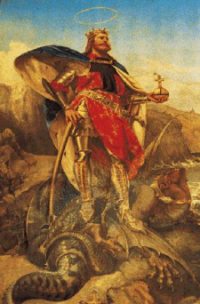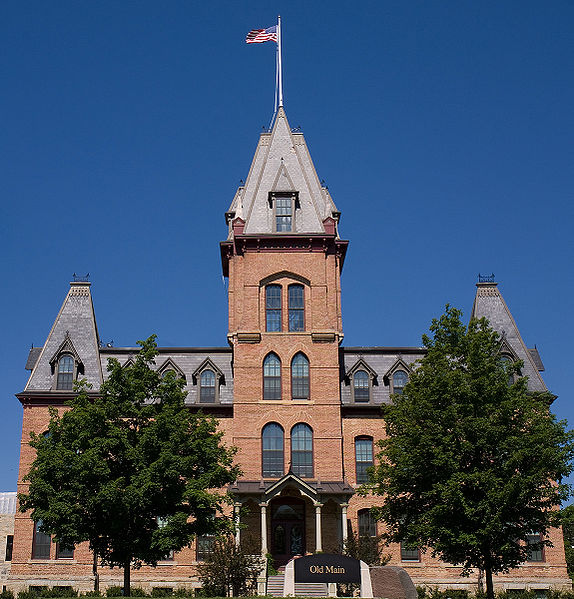OLAF (OH-loff)
1.
Patron of Norway and name of many Norwegian kings
2. St Olaf
College: Liberal arts college of Minnesota
Related
crosswordese: OLAV
Common clues: Minnesota's St. ____ College;
One of five Norwegian kings; Norse saint; Norwegian king; Big name
in Norway
Crossword
puzzle frequency:
4 times a year
Frequency
in English language:
35034 / 86800
Video: St
Olaf Mustache Appreciation Week
The given name Olav (Olaf, Olof, Olaus), the name of Saint Olav, patron of Norway, has also been borne by a number of other Norwegian kings. Conventions of spelling remain quite fluid, with Norwegian predominantly using Olav, and Swedish most often using Olaf or Olof.
Olav I of Norway (969 – September 9, 1000)
Olav II of Norway, Saint Olav, king 1015–1028
Olav III of Norway, king 1067–1093
Olav Magnusson, 1103–1110
Olav IV of Norway, king 1370 – August 23, 1387
Olav V of Norway, king 1957–1991
Olav II Haraldsson ( 995 – July 29 1030), king from 1015–1028, called during his lifetime the Stout and afterwards known as Saint Olaf, was born in the year in which Olaf Tryggvasson came to Norway. His father was Harald Grenske, great-grandchild of Harald I Fairhair.

After some years' absence in England, fighting the Danes, he returned to Norway in 1015 and declared himself king, obtaining the support of the five petty kings of the Uplands. In 1016 he defeated Earl Sweyn, hitherto the virtual ruler of Norway, at the Battle of Neaje, and within a few years had won more power than had been enjoyed by any of his predecessors on the throne.
He had annihilated the petty kings of the South, had crushed the aristocracy, enforced the acceptance of Christianity throughout the kingdom, asserted his suzerainty in the Orkney Islands, had humbled king Olof Skötkonung of Sweden and was for some time engaged to his daughter, the princess of Sweden, Ingegerd Skötkonung without his approval, and had conducted a successful raid on Denmark.
But his success was short-lived, for in 1029 the Norwegian nobles, seething with discontent, rallied round the invading Knut the Great, and Olaf had to flee to Kievan Rus. During the voyage he stayed some time in Sweden in the province of Nerike where, according to local legend, he baptized many locals. On his return a year later, seizing an opportunity to win back the kingdom after Knut the Great's vassal Håkon Jarl was lost at sea, he fell at the Battle of Stiklestad, where his own subjects were arrayed against him.
The succeeding years of disunion and misrule under the Danes explain the belated affection with which his countrymen came to regard him. The cunning and cruelty which marred his character were forgotten, and his services to his church and country remembered. Miracles were allegedly worked at his tomb, and his own death had peculiar circumstances (such as his hair and nails continuing to grow after he was dead). This was why he became canonized by Pope Alexander III in 1164. Some say that there is no proof of this, that he was never canonized (which is the case with many of the so-called canonized saints from this time and earlier; Neither Mary or any of the Apostles are formally canonized, for example.), and rather informally accepted as the patron saint of Norway, when his fame spread throughout Scandinavia and even to England, where churches are dedicated to him. The Norwegian order of Knighthood of Saint Olaf was founded in 1847 by Oscar I, king of Sweden and Norway, in memory of this king. He is called Rex Perpetuum Norvegiæ, eternal King of Norway.
The only country which keeps July 29th as a holiday are the Faroe Islands, see Ólavsøka.
***
St. Olaf College is a coeducational, residential, four-year, private liberal arts college in Northfield, Minnesota. It was founded in 1874 by a group of Norwegian-American immigrant pastors and farmers, led by Pastor Bernt Julius Muus. The college is named after Olaf II of Norway, former king and patron saint of Norway.

Old
Main
An average of six St. Olaf students are awarded the Fulbright Scholarship each year. Additionally, the college has produced nine Rhodes Scholars since 1910, including two in 2007.
St. Olaf ranks as one of the top 20 small colleges (those with 5,000 or fewer students) for the number of students who go on to serve in the Peace Corps.
St. Olaf College is listed in Loren Pope's Colleges That Change Lives.
The 2016 annual ranking by U.S. News & World Report rates it as tied for the 51st best among "National Liberal Arts Colleges" and tied for 6th in "Best Undergraduate Teaching" in the nation.
In the 2015 edition of the Washington Monthly college rankings, St. Olaf ranked 39th among liberal arts colleges. Washington Monthly assesses the quality of schools based on social mobility (recruiting and graduating low-income students), research (producing cutting-edge scholarship and PhDs), and service (encouraging students to give something back to their country).
This article is licensed under the GNU Free Documentation License. It uses material from the Wikipedia article "Olav", “Olaf II of Norway, and “St. Olaf College”.
|
|